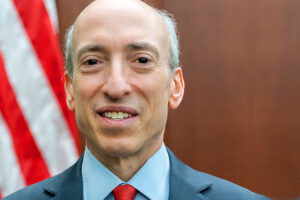Libor, the benchmark interest rate that was embedded in hundreds of trillions of dollars of financial contracts around the world, ceased publication at the end of June and regulators have warned that certain alternatives being considered in the markets present many of the same flaws.

Gary Gensler, chair of the US Securities and Commission Exchange, spoke before The Financial Stability Oversight Council on 28 July and compared Libor to “The Emperor’s New Clothes.”
Gensler said: “There were so few actual transactions underpinning LIBOR, that, as Hans Christian Andersen wrote in his famous folktale “The Emperor’s New Clothes,” this emperor had no clothes.”
After the financial crisis in 2008 regulators found multiple cases of banks manipulating Libor for their own profit and defrauding the public. As a result, policymakers came together to end Libor and move markets to risk-free rates based on underlying transactions, as they are harder to manipulate and more representative of the market. The publication of Libor eventually ended on 30 June 2023.
“In essence, we all knew we needed an emperor who was properly clothed,” said Gensler.
For example, to replace Libor US regulators chose SOFR (Secured Overnight Financing Rate) as an alternative to Libor and the UK chose SONIA (Sterling Overnight Index Average).
“We cannot, however, stop here,” he added. “There will be some pretenders, as there often are in the history of emperors.”
Gensler said it is important that any rate used to replace Libor be robust. He warned that certain alternatives being considered in the markets present many of the same flaws as Libor of thin markets with few underlying transactions, which will recreate a system vulnerable to collapse and manipulation.
“As I have said previously, I think the so-called credit sensitive rates, such as the BSBY rate (Bloomberg Short-Term Bank Yield Index), have infirmities that will not stand the test of time—and will not be good for financial stability or for future FSOC members,” added Gensler.
The International Organization of Securities Commissions (IOSCO) said in a report in July compared four benchmarks developed as potential substitutes for USD Libor against SOFR and said they had varying degrees of vulnerability. For example, the review concluded that due to liquidity risks in the bank-issued commercial paper and certificates of deposit market data.
“Absent modification, their use may threaten market integrity and financial stability,” said the report.
The Financial Stability Board also said in a statement in July that firms should use the most robust reference rates, anchored in deep, credible and liquid markets, in order to avoid the need to repeat the shift from Libor.
“Attempting to recreate rates that are based on Libor’s underlying wholesale unsecured markets leads to the same inherent vulnerabilities (e.g., excessive use of expert judgment and limited reliance on anchored transactions) and poses financial stability concerns,” said the FSB. “Using the more recently created ‘credit sensitive rates’ (CSRs) risks undermining the progress made through the decade-long Libor transition.”
SOFR trading volumes
Many markets transitioned to SOFR before Libor stopped being published.
In June this year the ISDA-Clarus RFR Adoption Indicator decreased slightly to 58.1% from 58.7% in the previous month which ISDA said was driven by higher federal funds trading activity.
The indicator tracks how much global trading activity (as measured by DV01) is conducted in cleared over-the-counter and exchange-traded interest rate derivatives that reference risk-free rates (RFR) in eight major currencies. On a traded notional basis, the percentage of RFR-linked interest rate derivatives increased to 55.6% of total transactions in June 2023 compared to 55.3% in May.
At CME Group, SOFR futures and options had their second highest quarterly annual daily volume of 4.7 million contracts in the second quarter of this year.
“Our successful, market-leading transition to SOFR has helped engender our short-term interest rate credentials with regional players and volume reached a single-day high of 23K contracts on June 30,” CME added.
CME also reported its second highest July ADV on record, with the strongest July in company history for interest rate, agricultural, and options products. SOFR futures ADV increased 57% to 2.8 million contracts and SOFR options ADV increased 204% to 1.2 million contracts.
This article was first published in Markets Media
©Markets Media Europe 2025















